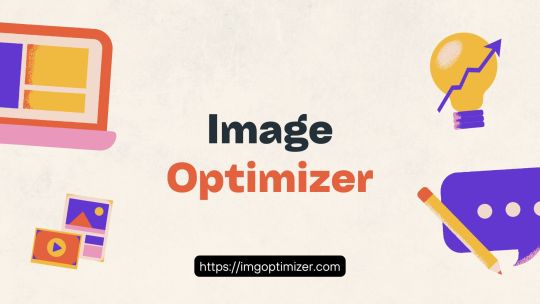Don't wanna be here? Send us removal request.
Text
Why Image Optimization Is Crucial for Your Website’s Success

In the fast-paced world of digital content, ensuring your website stands out is more important than ever. One key factor that often goes unnoticed is image optimization. Optimized images not only improve your site’s performance but also boost its search engine ranking. If you’re looking to enhance your website’s performance, here’s everything you need to know about why image optimization matters—and how tools like ImgOptimizer can help.
What Is Image Optimization?
Image optimization is the process of reducing an image’s file size without compromising its quality. This ensures faster loading times and a better user experience. It involves techniques like compression, resizing, and using the right image format (JPEG, PNG, or WebP).
Benefits of Image Optimizatio
1. Faster Website Loading Times
Large image files can slow down your website significantly, which may frustrate users and increase bounce rates. Optimized images load faster, ensuring a smoother experience for visitors.
2. Improved SEO Performance
Search engines like Google prioritize websites with faster loading speeds. By optimizing your images, you can improve your Core Web Vitals, leading to higher rankings on search engine results pages (SERPs).
3. Better User Experience (UX)
A fast-loading website enhances user satisfaction. Visitors are more likely to stay and explore your content when your pages load quickly and smoothly.
4. Reduced Bandwidth Usage
Smaller image files consume less bandwidth, which is especially important for mobile users and websites with heavy traffic.
5. Higher Conversion Rates
Fast-loading pages keep users engaged, increasing the likelihood of conversions, whether it’s a purchase, sign-up, or other desired actions.
How to Optimize Your Images
1. Choose the Right File Format
Use JPEG for photos.
Opt for PNG for images requiring transparency.
Consider WebP, a modern format offering high compression with excellent quality.
2. Compress Images
Compression reduces file size without affecting quality. You can use tools like Image Optimizer to simplify this process.
3. Resize Images
Ensure your images aren’t larger than necessary. For instance, if your website displays images at 800×600 pixels, there’s no need to upload a 3000×2000-pixel file.
4. Use Descriptive Alt Text
Alt text improves accessibility and helps search engines understand the context of your images
Why Use ImgOptimizer?
If you’re looking for an easy and effective way to optimize your images, Image Optimizer is your go-to solution.
Key Features of ImgOptimizer:
High-Quality Compression: Reduce file size without compromising quality.
Bulk Optimization: Save time by optimizing multiple images at once.
User-Friendly Interface: Perfect for beginners and professionals alike.
Supports Modern Formats: Optimize images in JPEG, PNG, and WebP formats.
By using ImgOptimizer, you’ll ensure your website is faster, more efficient, and SEO-friendly.
Conclusion
Image optimization is no longer optional; it’s a must for any website owner aiming for better performance and user engagement. By reducing image sizes and improving loading speeds, you can enhance your website’s overall functionality and search engine rankings.
Start optimizing your images today with ImgOptimizer and take your website’s performance to the next level! ����
0 notes